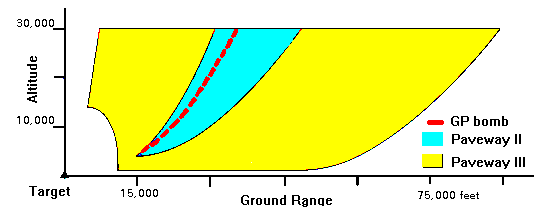ExNusquam
Posts: 513
Joined: 3/4/2014
From: Washington, D.C.
Status: offline

|
quote:
I understand the point you make regarding compressed ranges, the link I posted shows that the tactics approved and developed by all three US services and I suspect that much more widely by NATO airforces allowed for the employment of PGMs at low and very low altitudes, I concede that the docs I supplied have on average 2000ft release height however this gives a 3.2nm range for paveway II weapons, typical of a toss attack, and I would be happy acept that as a minimum.
You're absolutely correct, and I agree that LGBs can be employed from lower altitudes in real life, and it would be nice to see that implemented in C:MANO. I just think that weapon ranges need to reflect launch aircraft speed and altitude before release altitudes are lowered.
quote:
In the real world if the cloud base is 9900 ft, then the aircrew have the option to drop to 9900ft and prosecute the target. As things stand in CMNAO the player has no such option.
As this bugs me as well, my work around has always been buddy-lasing, which has worked since day 1.
quote:
You mentioned the DLZ, that again is a fair point and in an ideal world CMNAO would take that into account, however there are numerous things in CMNAO where the modeling is not as accurate as the real world , DESPITE the herculean efforts of the Devs to make it so, my point is that for example the the Kinematic torpedo ranges , can be set to either "realistic" or "Catalouge Ranges".
I suppose DLZ was the incorrect term to use - kinematic range is the point I was trying to make. Torpedoes are a special case in that due to their low speed relative to the target, they generally have to be used at very compressed ranges if they want to stand a chance of hitting their targets. The weapons in command have exactly the same performance regardless of the torpedo doctrine setting. All that changes is when the unit decides to open fire (the reason it's a doctrine setting not a realism setting, like detailed gun fire control). PGM range is not something that should be an option, since the player already has control over most of the things that govern it, speed and altitude (we can't control impact angle for JDAM but that's way beyond the scope of the simulation).
quote:
For GBU38 ... as you've said, inertia, kinetic enregy or simple, speed is ultimate factor for any glider range, so.. it is kinda, let me say, unusual, to compare A10 and F16 in level flight , where in A10 case with speed of 310kts@10000ft, bomb is traveling more balistic approach then in F16 case at 550kts@5000ft , .. with that 200kts difference , .. well you dont need any kind of planner to *imagine* difference ;) So , ~10nm range for any GBU is good range.
I don't doubt that the GBU-38 can really go 13NM when tossed by a tactical jet going 600+KTAS from 30,000'. I chose the A-10 example since I had the LAR card available in front of me, and it shows a significant split between the current C:MANO model and what the weapons will do in real life.
quote:
which reminds me an old case, in the initial testing of some glider, maybe even Paveway or JSOW, bomb has, upon release created so much lift that it pitched up, returned and hit the wing and broke it off, well.. sh*t. Suicide bomb..er.
Dumb bombs and fuel tanks will do this on inadequately simulated tests. This has more to do with airflow patterns across the aircraft and how that interacts with the released weapon. There's a reason that stores testing takes as long as it does on modern aircraft.
quote:
i don't really think you're going to get any real range out of a PGM without also modelling toss attacks. which is in the cards already probably somewhere.
PGMs releasing near the floor pretty much demands a ton of work on glide weapons for realistic modeling and while that would be cool we should probably wait for that instead of trying to bodge together an inaccurate modeling now with the current system.
just IMO
I concur 100%.
|
 Printable Version
Printable Version







 ), there are others for whom playabilty and enjoyment is more important, all am arguing for is the option and flexibilty for both to be catered for in CMNAO.
), there are others for whom playabilty and enjoyment is more important, all am arguing for is the option and flexibilty for both to be catered for in CMNAO. 

 New Messages
New Messages No New Messages
No New Messages Hot Topic w/ New Messages
Hot Topic w/ New Messages Hot Topic w/o New Messages
Hot Topic w/o New Messages Locked w/ New Messages
Locked w/ New Messages Locked w/o New Messages
Locked w/o New Messages Post New Thread
Post New Thread